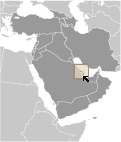World Atlas: Bahrain. On this page you can see the map, country flag and many detailed information about the people, history and economy of Bahrain.

Here you can find online selected information about the geography, inhabitants, government, economy and history of Bahrain. Included are selected statistics, an overview map and the detailed map of Bahrain. But let's start with the flag of Bahrain here:
Bahrain - Overview:
What you should know about Bahrain? Let's start with this: In 1783, the Sunni Al-Khalifa family took power in Bahrain. In order to secure these holdings, it entered into a series of treaties with the UK during the 19th century that made Bahrain a British protectorate. The archipelago attained its independence in 1971. A steady decline in oil production and reserves since 1970 prompted Bahrain to take steps to diversify its economy, in the process developing petroleum processing and refining, aluminum production, and hospitality and retail sectors. It has also endeavored to become a leading regional banking center, especially with respect to Islamic finance. Bahrain's small size, central location among Gulf countries, economic dependence on Saudi Arabia, and proximity to Iran require it to play a delicate balancing act in foreign affairs among its larger neighbors. Its foreign policy activities usually fall in line with Saudi Arabia and the UAE. The Sunni royal family has long struggled to manage relations with its large Shia-majority population. In early 2011, amid Arab uprisings elsewhere in the region, the Bahraini Government confronted similar pro-democracy and reform protests at home with police and military action, including deploying Gulf Cooperation Council security forces to Bahrain. Political talks throughout 2014 between the government and opposition and loyalist political groups failed to reach an agreement, prompting opposition political societies to boycott legislative and municipal council elections in late 2014. Ongoing dissatisfaction with the political status quo continues to factor into sporadic clashes between demonstrators and security forces.
Geography of Bahrain
 Where on the globe is Bahrain? The location of this country is Middle East, archipelago in the Persian Gulf, east of Saudi Arabia. Total area of Bahrain is 760 sq km, of which 760 sq km is land. So this is quite a small country. How could we describe the terrain of the country? This way: mostly low desert plain rising gently to low central escarpment. The lowest point of Bahrain is Persian Gulf 0 m, the highest point Jabal ad Dukhan 135 m. And the climate is arid; mild, pleasant winters; very hot, humid summers.
Where on the globe is Bahrain? The location of this country is Middle East, archipelago in the Persian Gulf, east of Saudi Arabia. Total area of Bahrain is 760 sq km, of which 760 sq km is land. So this is quite a small country. How could we describe the terrain of the country? This way: mostly low desert plain rising gently to low central escarpment. The lowest point of Bahrain is Persian Gulf 0 m, the highest point Jabal ad Dukhan 135 m. And the climate is arid; mild, pleasant winters; very hot, humid summers.
Inhabitants of Bahrain
Let's take a look how many people live in Bahrain. The number is: 1,410,942 (July 2017 est.). So not so many people live here. Who lives here? Bahraini 46%, Asian 45.5%, other Arab 4.7%, African 1.6%, European 1%, other 1.2% (includes Gulf Co-operative country nationals, North and South Americans, and Oceanians) (2010 est.). What are the languages in Bahrain? Arabic (official), English, Farsi, Urdu. And the religions: Muslim 70.3%, Christian 14.5%, Hindu 9.8%, Buddhist 2.5%, Jewish 0.6%, folk religion . How old are the people in average? 32.3 years. We have to add that this number is the median - so one half of the people is older than this, one half is younger. And what is their life expectancy (at birth)? This: 79 years. Where the people live in Bahrain? Here: smallest population of the Gulf States, but urbanization rate exceeds 90%; largest settlement concentration is found on the far northern end of the island in and around Manamah and Al Muharraq. The major urban areas of Bahrain are: Manama (capital) 411,000 (2015).
Government and Economy of Bahrain
The capital of Bahrain is Manama and the government type constitutional monarchy. Let's take a look at the administrative divisions - 4 governorates (muhafazat, singular - muhafazah); Asimah (Capital), Janubiyah (Southern), Muharraq, Shamaliyah (Northern). Regarding the economy of Bahrain, important industrial products are petroleum processing and refining, aluminum smelting, iron pelletization, fertilizers, Islamic and offshore banking, insurance, ship repairing, tourism. Important agricultural products are fruit, vegetables; poultry, dairy products; shrimp, fish. The most important export commodities are petroleum and petroleum products, aluminum, textiles and the most important export partners are Saudi Arabia 18.3%, UAE 17.5%, US 11.1%, Japan 8.7%, Qatar 4.8%, China 4.2% (2016). The most important import commodities are crude oil, machinery, chemicals and the most important import partners are China 9.7%, US 8.6%, UAE 7.4%, Japan 6.1%, Saudi Arabia 5.5% (2016). How rich is Bahrain and how rich are people in this country? The most important number here is GDP per capita (PPP): $51,800 (2017 est.). This means the people are rich on average here. Let's add that this means Gross Domestic Product per person, which is recalculated with respect to the relative cost of local goods and services. And one more important number - population below poverty line: NA%.